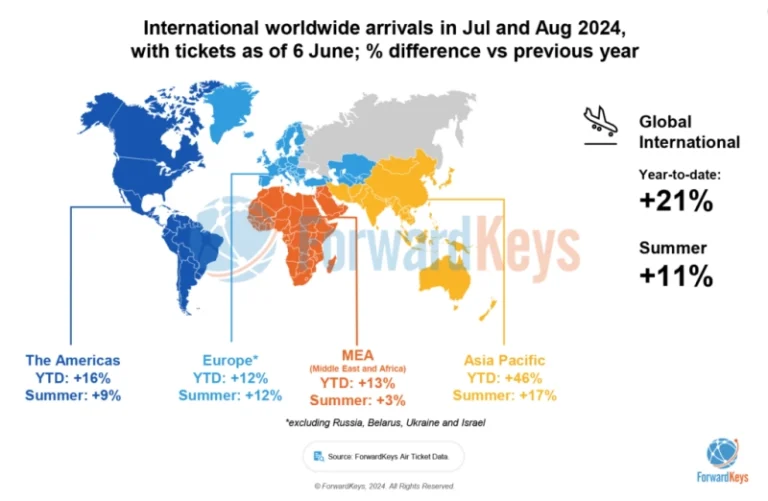As revealed in a recent ForwardKeys webinar in partnership with ETOA, Europe is on track to have an exceptional summer, with inbound tourism expected to surpass previous records. Overall, international arrivals to Europe in July and August showed a +12% increase year-on-year, slightly above the global average (+11%). This growth is primarily driven by intra-regional travel (+10% compared to 2023) and a significant influx of visitors from long-haul markets in Asia Pacific (+11%) and the US (+21%).

Increases in flight searches and ticket bookings indicate strong interest in European destinations despite the lingering impact of global economic challenges, including due to major events taking place over the summer. However, economic uncertainty may also be reflected in accelerating growth in economy class seats (+11%) into 2023, while premium class tickets remain at 2023 levels (+1%).
After slow economic resurgence, Central and Eastern Europe is fastest growing
Central and Eastern Europe are witnessing the fastest growth in inbound tourism after a delayed resurgence due to the war in Ukraine. The region is expected to see a 23% increase in tourist numbers this summer compared to last. Northern Europe is also set to grow faster (+12%) than Southern Europe (+10%), reflecting a widespread recovery trend across all European sub-regions.
Top cities lead urban destinations
Urban destinations are leading the way in Europe’s tourism recovery, overtaking traditional sun and beach holidays. Cities such as Munich (+37%), benefiting from major sporting events this summer, are experiencing significant growth. This trend is balanced across European sub-regions, with strong increases across the continent in Vienna (+23%), Edinburgh (+19%), Madrid (+16%) and Venice (+16%).

While medium-term stays continue to account for the largest proportion of regional arrivals (63%), shorter trips of 1 to 3 nights will see the strongest growth at +23% through to 2023, accounting for 16% of all stays. Longer trips over two weeks will see slower growth at +5%.
China and Japan lead the way in revitalizing the Asia-Pacific region
Asia Pacific is beginning to show signs of revival, with significant increases in arrivals from China (+64%) and Japan (+53%) compared to 2023. While overall volumes are still below pre-pandemic levels, improved air connectivity has seen a surge in travellers from these countries. China in particular accounts for a much larger share of seats (+12 points) than before the pandemic, but this is because connectivity between China and the US remains limited, with Chinese airlines instead deploying wide-body aircraft on routes to Europe.

Multi-destination trips are also in demand in the Asia Pacific market this summer, with standout city pairs including Budapest-Vienna (+118%), Milan-Munich (+106%), Prague-Amsterdam (+71%) and Istanbul-Athens (+63%), reflecting the popularity of European city destinations for Asian travelers looking to combine culture, history and shopping activities.
Events continue to drive demand
Events play a key role in boosting tourism demand. Arrivals to Germany, host of the UEFA Euro 2024 football tournament, show a +19% growth compared to the same period in 2023. Travel demand during the Paris Olympics is also higher than last year, with markets such as China (+124%), Japan (+57%), Germany (+32%) and the US (+25%) doing well. Looking at destination cities on Taylor Swift’s Eras tour, we see a significant increase in arrivals around the concert dates compared to the summer as a whole. These include Stockholm (+136% vs +15%), Warsaw (+203% vs +31%) and London (+45% vs +12%).
These small changes, which are closely tied to the dates of specific events, highlight the importance of major events in driving growth even during economic downturns, as demand for “once in a lifetime” experiences remains high. Destinations with well-developed infrastructure, such as stadiums, concert halls and festival venues, stand to benefit greatly.
Conclusion
The outlook for tourism in Europe this summer is extremely positive, with record growth expected, driven by intra-regional travel and key markets such as the United States and Asia Pacific, and Europe experiencing a tourism recovery well above the global average.
The rapid reinvigoration of Central and Eastern Europe, the dominance of urban destinations, a resurgence in travel from the Asia-Pacific region and the impact of major events all contribute to this optimistic forecast. European destinations are well positioned to take advantage of these trends as the season progresses.
However, amid widely publicised mass anti-tourism protests in some of Europe’s most popular tourist destinations, the importance of accurate and reliable travel information to sustainably manage tourist flows and balance the interests of tourists and local residents has become more apparent than ever.

